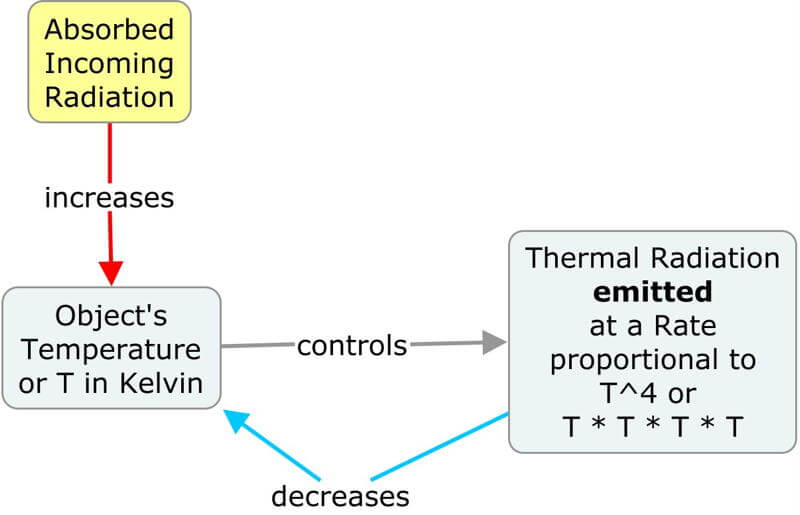Interaction of Radiation with Matter
Photons can travel through a vacuum forever (or at least a very, very long time) until they encounter matter. When photons run into atoms and molecules, there are three fundamental ways in which they interact with the matter: absorption, reflection, and transmission.
Absorption
When matter captures or absorbs photons, the amount of energy within the object increases. The radiation energy gets converted into other types of energy, such as heat or, during photosynthesis, chemical energy. If the material heats, then it radiates more thermal energy (remember, the amount of energy released is proportional to the temperature in degrees Kelvin to the fourth power!). This emitted energy cools the object, creating negative feedback, which ensures that the temperature will eventually stop increasing. Most objects that absorb visible light do not heat to a temperature that they emit visible light. A body needs to be at least 400ºC (750ºF) to radiate a very dim red light, whereas an object warmed in the sunlight tends to emit most of its thermal radiation in the mid- to far-infrared spectrum.

A concept map of the negative feedback process when radiation is absorbed, transformed into heat, and emitted as thermal radiation. Start with the absorbed incoming radiation (highlighted in yellow). Notice that two processes affect the object’s temperature: one that warms it, and the process that cools it depends on the object’s temperature.
Acknowledgments: Mattea Horne and Mort Sternheim provided invaluable suggestions to improve this concept map.
Reflection
When a photon reflects off a surface, the amount of energy within the matter doesn’t change, but the direction the photon is moving does change. The reflected visible light is how we see objects that don’t emit these wavelengths. An animal’s color vision takes advantage of the information provided by reflected light.
Since our color vision provides so much information to us, we often forget about the colors that are absorbed. Black fabric absorbs all wavelengths of visible light and reflects none. White reflects all wavelengths of visible light and absorbs none. A blue billiard ball absorbs all wavelengths except blue.

Flowers are often colorful to attract pollinators. The camera captured the light reflected from the leaves and flower petals.
Transmission
When a photon passes or transmits through the material’s matter, the amount of energy within the object doesn’t change. Transparent materials let all visible wavelengths through, but some translucent materials, such as filters or leaves, allow only limited parts of the EM spectrum to transmit through them.

Setting up the camera to photograph the wavelengths of sunlight that transmit through the leaf shows that green light passes through the foliage.
Incoming Radiation = Absorbed + Reflected + Transmitted
Scientists, engineers, doctors, and dentists (among many others!) analyze our world and universe using the electromagnetic spectrum. We study the chemical composition and temperature of stars, detect the health of vegetation from aerial and satellite images, monitor ocean plankton blooms, detect problems inside our body, measure air quality, etc., using various wavelengths of light. But in many cases, we need to understand how much of the incoming radiation is absorbed, transmitted, and reflected. Sometimes it isn’t easy to measure one of these parameters, particularly the amount of absorption. By measuring the intensity and spectrum of the incoming radiation illuminating the object and the amounts reflected and transmitted, we can calculate the amount absorbed.
Absorbed = Incoming Radiation – Reflected – Transmitted
In the two pictures of the green leaves above, one shows that plant leaves reflect green light, while the other shows that green light transmits through the foliage. From these observations, it is reasonable to conclude that the leaves absorb very little green light. The remaining wavelengths of visible light are absorbed, and they help drive photosynthesis.
Additional Ways Light Interacts with Matter
Absorption, reflection, and transmission aren’t the only ways light interacts with matter, but they are fundamental processes. Light is complicated, as photons act both as a wave and a particle, so additional processes are critical in how sunlight travels through our atmosphere. The following are brief definitions and examples of these phenomena. Use the links to learn about the processes in greater detail.
Refraction is the bending of radiation as it passes from one transparent substance into another due to the different speeds of the photons in the two materials. All lenses in telescopes, cameras, magnifying glasses, glasses, contacts, etc., work because of refraction. The refraction of light in our atmosphere alters the positions of the stars and sun in the sky. Refraction creates rainbows, sundogs, halos, and more in the sky.
Scattering is when photons depart from their straight path of motion due to imperfections in the medium, but it is different than reflection. During scattering, the photon is fully absorbed and then emitted. During reflection, the photon bounces off the surface. There are quite a variety of causes of scattering. Most notably, scattering produces the color of our sky.
Diffraction refers to the apparent bending of waves around small obstacles and the spreading out of waves past small openings. Diffraction creates the corona around the moon.
Polarization is the process of transforming unpolarized light into polarized light. Vibrating electric charges produce photons, and so the waves vibrate in all directions. When waves interact with matter, their vibrations may become aligned, creating polarized light. Polarization occurs during transmission, reflection, refraction, and scattering.
Some animals can see polarized light. The scattered blue light in the sky is polarized, and bees use it to navigate and find food. Butterflies use polarized light to find food, locate where to lay their eggs, and recognize their mates. Most sunglasses for humans are polarizing filters that darken the sky and block most light reflected from the water.

Movie showing the subtle polarization of light reflected from the leaves that butterflies detect to find where to lay their eggs.
Big Ideas
- When photons run into atoms and molecules, there are three fundamental ways in which they interact with the matter: absorption, reflection, and transmission.
- When matter captures or absorbs photons, the amount of energy within the object increases.
- When a photon reflects off a surface, the amount of energy within the matter doesn’t change, but the direction the photon is moving does change.
- When a photon passes or transmits through the material’s matter, the amount of energy within the object doesn’t change.
- Absorption, reflection, and transmission aren’t the only ways light interacts with matter: refraction, scattering, diffraction, and polarization may also occur.

Hi there! I could have sworn I’ve visited this website before but
after going through some of the articles I realized it’s new to me.
Nonetheless, I’m certainly pleased I discovered it and I’ll be bookmarking it and checking
back frequently!